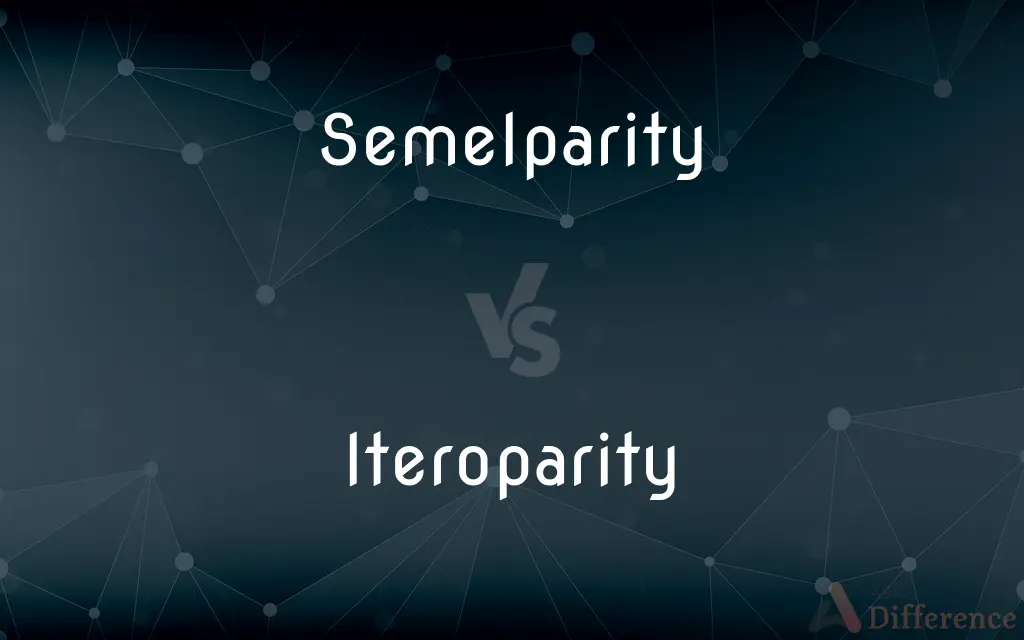Semelparity vs. Iteroparity — What's the Difference?
By Urooj Arif & Fiza Rafique — Updated on May 9, 2024
Semelparity involves organisms breeding only once before death, while iteroparity features repeated reproductive cycles throughout their lives.

Difference Between Semelparity and Iteroparity
Table of Contents
ADVERTISEMENT
Key Differences
Semelparity is a reproductive strategy where an organism reproduces once and then dies, focusing all its energy on a single, often large, reproductive event. Whereas iteroparity involves organisms that reproduce multiple times over the course of their lives, spreading the risk and potential success over several smaller events.
In semelparity, the offspring usually have a higher survival rate due to the significant investment in that single reproductive effort. On the other hand, iteroparous species may have lower per-event survival rates for offspring but benefit from multiple opportunities to pass on their genes.
Environmental factors heavily influence these reproductive strategies; semelparity often occurs in more unpredictable environments, maximizing reproductive output in a single event. Conversely, iteroparity is favored in more stable environments where ongoing survival and repeated reproduction are more viable.
The energy allocation in semelparous organisms is geared entirely towards growth and reproduction in one monumental effort. In contrast, iteroparous species allocate energy more conservatively across multiple reproductive cycles, balancing between growth, maintenance, and reproduction.
From an evolutionary perspective, semelparity can be advantageous in scenarios where adult survival is low, thus making a once-in-a-lifetime reproductive event more sensible. Iteroparity suits environments where individuals are likely to survive to reproduce again, thereby taking advantage of multiple reproductive cycles.
ADVERTISEMENT
Comparison Chart
Eproductive Frequency
Once in a lifetime
Multiple times throughout life
Energy Investment
High investment in one event
Lower investment per event, spread over time
Offspring Survival Rate
Higher per event due to large investment
Lower per event, cumulative survival can be higher
Environmental Adaptation
Suited to unpredictable environments
Suited to stable environments
Evolutionary Advantage
Maximizes output in short lifespan conditions
Exploits longevity and stable conditions
Compare with Definitions
Semelparity
Often associated with unpredictable environmental conditions.
Some plants in desert areas are semelparous, adapting to harsh, uncertain climates.
Iteroparity
Favored in stable, predictable environments.
Many bird species, like robins, nest and raise chicks repeatedly each year.
Semelparity
Characterized by high energy investment in a singular reproductive effort.
Many insects like the mayfly die after their first and only reproductive event.
Iteroparity
Common among vertebrates and perennial plants.
Oak trees produce acorns yearly over centuries.
Semelparity
A reproductive strategy involving only one reproductive cycle before death.
Pacific salmon exhibit semelparity, spawning once and then dying.
Iteroparity
Allows for ongoing genetic contribution across different environmental conditions.
Sea turtles lay eggs at several times during their lives, increasing genetic diversity.
Semelparity
Leads to a potentially high offspring mortality rate.
Bamboo species flower once every several decades before dying, risking massive offspring loss.
Iteroparity
A reproductive strategy involving multiple reproductive cycles over the organism's lifetime.
Elephants are iteroparous, giving birth to several calves over their lifetimes.
Semelparity
Seen in both plants and animals.
Agave plants take many years to mature, flower once, and then die.
Iteroparity
Characterized by repeated, less intense energy investments in reproduction.
Most perennial plants, like apple trees, flower annually.
Semelparity
(biology) The condition of being semelparous
Iteroparity
(biology) The condition of being iteroparous
Common Curiosities
What is semelparity?
Semelparity refers to a biological strategy where an organism reproduces once, then dies.
Why might an environment favor semelparity?
Harsh or unpredictable conditions can favor semelparity as it maximizes the chances of reproduction before death.
How does semelparity affect population dynamics?
It can lead to population boom and bust cycles, with large numbers of offspring followed by mass die-offs.
What is iteroparity?
Iteroparity is a reproductive strategy where an organism reproduces multiple times over its lifespan.
How does semelparity differ from iteroparity in terms of energy investment?
Semelparity involves a large, one-time energy investment in reproduction, whereas iteroparity spreads the energy investment over multiple reproductive events.
Can you give an example of a semelparous organism?
The octopus is an example, which breeds once and then typically dies shortly after.
Are there any risks associated with iteroparity?
While less risky per event, iteroparous species must survive multiple events, making them vulnerable over time.
Is semelparity more common in certain taxa?
Yes, it is more common in certain insects and annual plants.
Can you give an example of an iteroparous organism?
Deer are iteroparous, breeding annually throughout their adult lives.
Why might an environment favor iteroparity?
Stable environments with fewer threats to adult survival favor iteroparity, allowing multiple reproductive opportunities.
How does iteroparity affect population stability?
Iteroparity tends to promote more stable populations with gradual changes in size.
Are there any risks associated with semelparity?
Yes, if the single reproductive event fails, it could mean the end of that organism's genetic contribution.
How do semelparous species contribute to their ecosystem?
They can trigger nutrient cycles, especially when large numbers die and decompose.
Is iteroparity more common in certain taxa?
Yes, it is prevalent in vertebrates and perennial plants.
How do iteroparous species contribute to their ecosystem?
They provide ongoing contributions through repeated seeding, breeding, and ecological interactions.
Share Your Discovery

Previous Comparison
QED vs. QCD
Next Comparison
Cigarette vs. TabAuthor Spotlight
Written by
Urooj ArifUrooj is a skilled content writer at Ask Difference, known for her exceptional ability to simplify complex topics into engaging and informative content. With a passion for research and a flair for clear, concise writing, she consistently delivers articles that resonate with our diverse audience.
Co-written by
Fiza RafiqueFiza Rafique is a skilled content writer at AskDifference.com, where she meticulously refines and enhances written pieces. Drawing from her vast editorial expertise, Fiza ensures clarity, accuracy, and precision in every article. Passionate about language, she continually seeks to elevate the quality of content for readers worldwide.













































